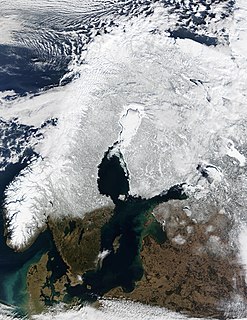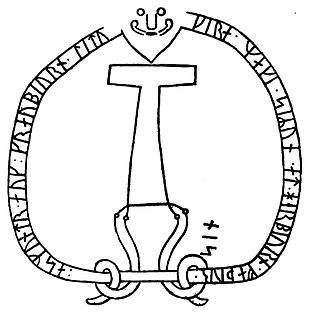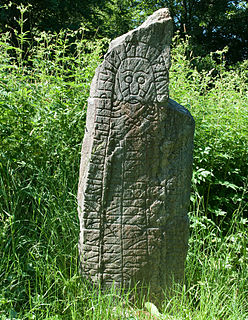
The Funbo runestones constitute a group of four runestones originally from Funbo in the province of Uppland, Sweden, which were raised by members of the same family during the eleventh century.
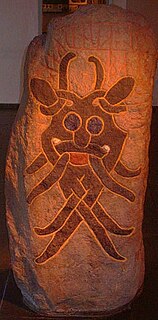
Danish Runic Inscription 66 or DR 66, also known as the Mask stone, is a granite Viking Age memorial runestone that was discovered in Aarhus, Denmark. The inscription features a facial mask and memorializes a man who died in a battle.

The Norra Härene Runestone, designated as Vg 59 by Rundata, is a Viking Age memorial runestone that is located on the grounds of Dagsnäs Castle, which is about seven kilometers south of Skara, Västra Götaland County, Sweden, in the historic province of Västergötland.

The Gardarike Runestones are runestones in Scandinavia that mention voyages to the East (Austr) or the Eastern route (Austrvegr), or to more specific eastern locations such as Garðaríki.

Uppland Runic Inscription 1034 or U 1034 is the Rundata catalog number for a runic inscription on a runestone located at the Tensta Church, which is three kilometers northwest of Vattholma, Uppsala County, Sweden, and in the historic province of Uppland, that was carved in the late 11th or early 12th century. While the tradition of carving inscriptions into boulders began in the 4th century and lasted into the 12th century, most runestones date from the late Viking Age.

Uppland Runic Inscription 308 or U 308 is the Rundata catalog designation for a memorial runestone that is located in Ekeby, Stockholm County, Sweden, which was in the historic province of Uppland. While the tradition of carving inscriptions into boulders began in the 4th century and lasted into the 12th century, most runestones date from the late Viking Age.

Sö 109 is the Rundata designation for a runic inscription on a Viking Age memorial runestone that is located in Gredby, which is near Eskilstuna, Södermanland County, Sweden, which was in the historic province of Södermanland.

This runic inscription, designated as U 448 in the Rundata catalog, is on a Viking Age memorial runestone located in Harg, which is about 4 kilometers north of Märsta, Stockholm County, Sweden, which was in the historic province of Uppland.
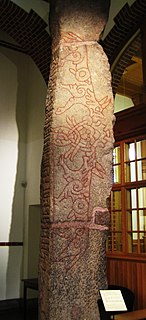
The Lund 1 Runestone, designated as DR 314 in the Rundata catalog, is a Viking Age memorial runestone originally located on the grounds of the All Saints Church in Lund, Scania, Sweden.

Sö 328 is the Rundata catalog number for a runic inscription on a Viking Age memorial runestone which is located in Tynäs, which is about one kilometer east of Strängnäs, Södermanland County, Sweden, which is in the historic province of Södermanland.

Uppland Runic Inscription 80 or U 80 is the Rundata catalog listing for a Viking Age memorial runic inscription that is located in Sundby, which is in Solna Municipality, Stockholm County, Sweden, and in the historic province of Uppland.

Östergötland Runic Inscription 224 or Ög 224 is the Rundata catalog number for a Viking Age memorial runestone that is located in Stratomta, which is 9 kilometers east of Linköping, Östergötland, Sweden. The runestone has an inscription on two sides with an image of a ship on the south side.
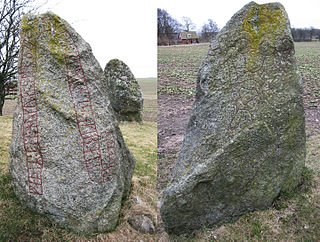
The Västra Strö 2 Runestone, listed as DR 335 in the Rundata catalog, is a Viking Age memorial runestone located at the Västra Strö Monument, which is at a church that is about four kilometers northwest of Eslöv, Skåne County, Sweden.
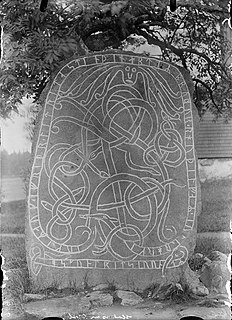
Uppland Runic Inscription 824 is the Rundata catalog number for a Viking Age memorial runestone located at Holms, which is about eight kilometers east of Örsundsbro, Uppsala County, Sweden, and in the historic province of Uppland. The inscription features a facial mask and a bind rune in the text.
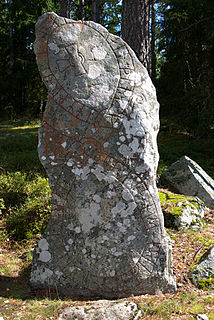
Sö 292 is the Rundata catalog number for a Viking Age memorial runestone located in Bröta, which is about six kilometers southwest of Väländan, Stockholm County, Sweden, in the historic province of Södermanland.
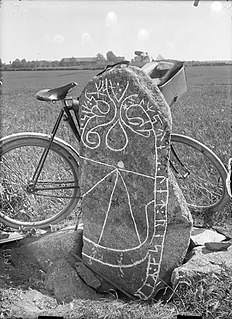
Västmanland Runic Inscription 17 or Vs 17 is the Rundata designation for a Viking Age memorial runestone with an image of a ship that is located in Råby, which is about two kilometers east of Tortuna, Västmanland County, Sweden, which was in the historic province of Västmanland.
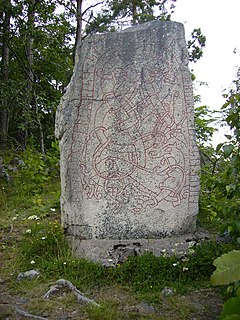
The Nasta Runestone, listed as Nä 34 in the Rundata catalog, is a Viking Age memorial runestone located in Nasta, which is 3 kilometers northwest of Glanshammar, Örebro County, Sweden, which was in the historic province of Närke.
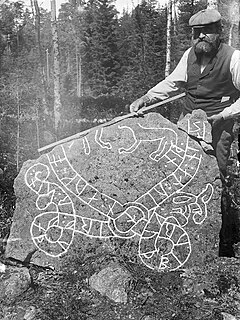
Södermanland Runic Inscription 235 or Sö 235 is the Rundata listing for a Viking Age memorial runestone fragment that is located in Västerby, which is six kilometers southwest of Väländan, Stockholm County, Sweden, and in the historic province of Södermanland.

